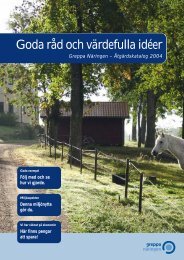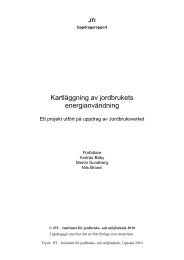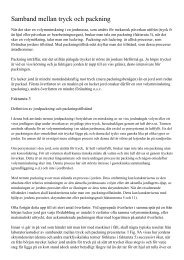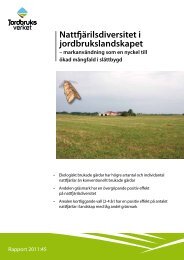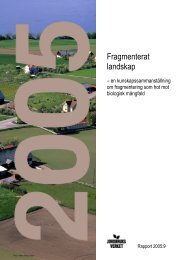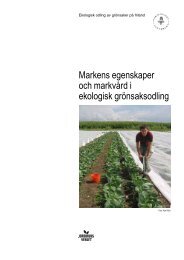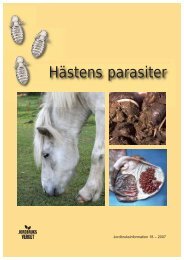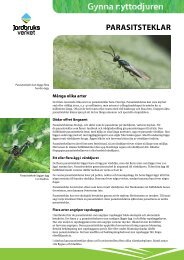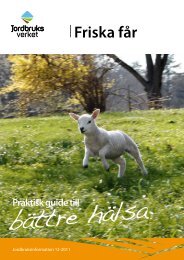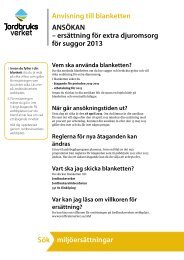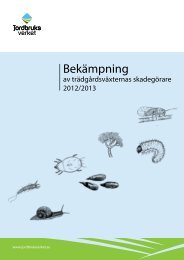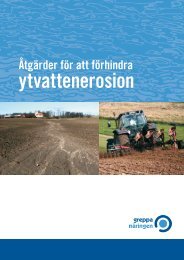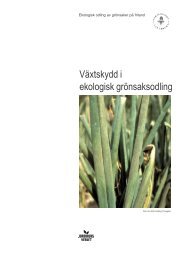Strategies for detection and delimitation surveys of ... - Jordbruksverket
Strategies for detection and delimitation surveys of ... - Jordbruksverket
Strategies for detection and delimitation surveys of ... - Jordbruksverket
Create successful ePaper yourself
Turn your PDF publications into a flip-book with our unique Google optimized e-Paper software.
aits have been developed <strong>for</strong> M. galloprovincialis in southern Europe (Ibeas et al.<br />
2007; Francardi et al. 2009; Pajares et al. 2010). Operative baits are now also<br />
commercially available. In the summer <strong>of</strong> 2011 I tested these baits in Sweden <strong>and</strong><br />
could demonstrate that they also are attractive <strong>for</strong> M. sutor <strong>and</strong> the northern race<br />
<strong>of</strong> M. galloprovincialis (unpublished results from a project conducted in cooperation<br />
with Juan Pajares, University <strong>of</strong> Vallodolid, Spain).<br />
To collect living beetles without traps requires that they have emerged from their<br />
breeding material <strong>and</strong> warm sunny weather (when the beetles are active). Thus,<br />
the time period <strong>for</strong> sampling is rather limited (preferably June, July <strong>and</strong> first half<br />
<strong>of</strong> August) <strong>and</strong> the method is very dependent on the weather (if cold or rain no<br />
beetles will be active). Thus, to use traps baited with attractants is a more efficient<br />
method. The disadvantages with traps are (1) the cost <strong>for</strong> the traps <strong>and</strong> attractants,<br />
(2) the cost spent on setting up the traps, <strong>and</strong> (3) the cost spent on travelling<br />
around <strong>and</strong> emptying the traps. One problem is also that the beetles preferably<br />
need to be alive when dissected <strong>for</strong> nematodes. Thus, the traps need to be emptied<br />
at least once a week <strong>and</strong> provided with food <strong>for</strong> the beetles (fresh pine twig). In<br />
addition, the beetles must be kept alive until they arrive at the nematode laboratory.<br />
If a nematode laboratory outside Sweden is used <strong>for</strong> analyzing the samples it<br />
may also be a problem to send living Monochamus beetles to another country.<br />
As a result <strong>of</strong> the strong association between PWN <strong>and</strong> Monochamus beetles the<br />
most efficient way <strong>of</strong> sampling wood is to focus on dead wood objects with the<br />
characteristic larval galleries or emergence holes <strong>of</strong> Monochamus beetles. But also<br />
living trees with symptoms that could indicate the presence <strong>of</strong> PWD could be<br />
sampled. Sampling <strong>of</strong> living trees without symptoms or dead wood without signs<br />
<strong>of</strong> Monochamus colonization should generally not be conducted (with the exception<br />
<strong>of</strong> a situation when it is strongly suspected that PWN-infested Monochamus<br />
beetles have conducted their maturation feeding in an given location). The easiest<br />
way to find dead wood colonized by Monochamus is to search <strong>for</strong> cutting residues<br />
(tops, large branches, low quality stem parts) on clear-cuts (see above). The<br />
advantages with this method are: (1) a rather high probability <strong>of</strong> finding colonized<br />
objects, (2) long time period <strong>for</strong> sampling (all year around except <strong>for</strong> when deep<br />
snow), (3) many available clear-cuts spread out all over Sweden, <strong>and</strong> (4) available<br />
GIS data on exactly where these clear-cuts are located <strong>and</strong> the age <strong>of</strong> the clearcuts.<br />
Some disadvantages are that: (1) in some areas suitable clear-cuts may not be<br />
available, (2) if specific risk areas are identified (e.g. close to urban areas) there<br />
may not be any clear-cuts at all or <strong>of</strong> suitable age there, (3) we do not know to<br />
what extent M. galloprovincialis reproduce in logging residues.<br />
To conclude, sampling <strong>of</strong> Monochamus-colonized logging residues on clear-cuts<br />
seems to be a superior sampling method compared to sampling living beetles with<br />
traps if samples from many distant localities are the goal. But, sampling with<br />
baited traps is an interesting compliment <strong>for</strong> areas lacking suitable clear-cuts <strong>and</strong><br />
<strong>for</strong> assuring that also M. galloprovincialis populations are included in the <strong>surveys</strong>.<br />
Thus, a combination <strong>of</strong> sampling <strong>of</strong> Monochamus-infested wood on clear-cuts <strong>and</strong><br />
traps baited with odor baits is the method advocated in the following text.<br />
11



